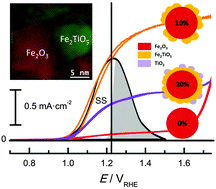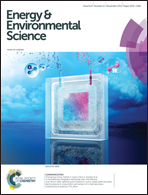What do you do, titanium? Insight into the role of titanium oxide as a water oxidation promoter in hematite-based photoanodes†
Abstract
Hematite (α-Fe2O3) is a promising photoanode in solar water splitting devices with a set of intrinsic limitations that lessen its maximum performance; among the methods used for improving its photoactivity, titanium doping has witnessed an intensive research during recent years. However, the origin of the Ti-induced enhancement remains elusive to date with the lack of a systematic mechanistic study. In this contribution, we prepared mesoporous hematite (host)–titania (guest) composite films by mixing the respective preformed nanoparticles obtained by a non-aqueous sol–gel route in a wide range of loading levels (0–20 mol%) up to the solid state solubility limits of both components. Voltammetric and impedance measurements were performed observing an optimum 10% doping, with a 15-fold photocurrent increase (up to 1.3 mA cm−2 at 1.23 VRHE) and a 100-fold decrease in the charge transfer resistance. The roles of surface states and charge donor (dopant) densities were also assessed, assuming a charge transfer mechanism through hole trapping at surface states and its isoenergetic transfer to water; an optimum 10–15% doping range was obtained similarly to photocurrent, where the maximum overlapping between surface and water states is prevalent. Finally, HR-TEM and EELS measurements were employed to detect the presence of pseudobrookite and titania phases (20% doping), evincing that hematite–pseudobrookite heterojunctions have a beneficial cascade of charge transfers but titania-pseudobrookite heterojunctions depict a deleterious “hole mirror” mechanism that prevents water photooxidation. Tailoring the combined effect of donor states (conductivity), phase coexistence (solubility), heterojunctions (energetics) and surface states (kinetics) in the composite paves the way for understanding the mechanism of other dopant-induced changes and could be extended to further photoactive materials.



 Please wait while we load your content...
Please wait while we load your content...